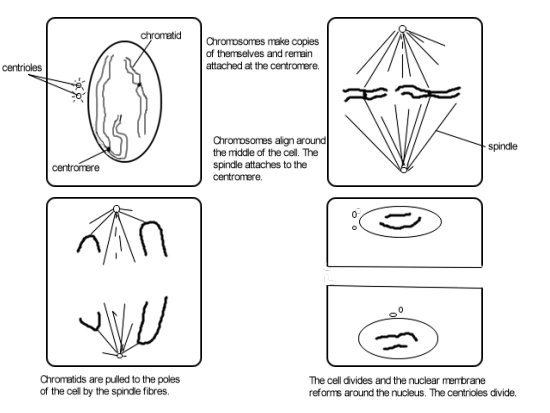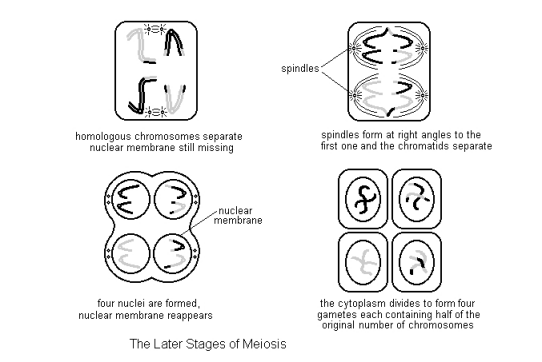Cell Division
There are two types of cell division. Mitosis produces daughter cells which are genetically identical to the parent cell. This type of cell division is used in growth. Meiosis produces daughter cells which have half the correct number of chromosomes. This type of cell division is used to make sex cells (gametes) for use in sexual reproduction.
Mitosis
The cell starts by making a copy of each chromosome. Each copy of the chromosome (called a chromatid) remains attached to each other at a central region called a centromere. The long threads of DNA start to coil very tightly and become visible under the microscope. The membrane around the nucleus disappears and two special structures called centrioles migrate to opposite ends of the cell. The chromosomes align along an imaginary mid-point of the cell. A 'spindle' forms from special fibres from each centriole. Some of these fibres eventually connect with the centromere of a chromosome. When all the centromeres are attached the fibres shrink, pulling apart the chromatids so they migrate to the opposite ends of the cell. A nuclear membrane forms around each new nucleus as the cell itself begins to divide into two. The chromosomes unwind and the cell division is complete. Each daughter cell is an exact copy of the parent cell.

Meiosis
Cell division begins in a similar fashion to mitosis. Each chromosome makes a copy of itself and the copies remain attached at the centromere. The chromosomes coil and the nuclear membrane disappears. The centrioles begin to migrate to opposite ends of the cell.

Then the chromosomes begin to pair up in homologous pairs. A homologous pair of chromosomes have genes which code for similar characteristics in similar places on the chromosome (For example if one of the chromosomes had on it a gene for blue eyes its homologous chromosome would have a gene for eye colour in a similar position, but it may be brown instead of blue). The homologous pairs often twist around each other so tightly that bits of the chromatid break off. The cell's repair system fixes the break but sometimes puts the wrong chromatid on the wrong chromosome in the pair. This is called a chiasmata and helps variation by mixing up genes.
The spindle forms and instead of pulling apart the chromatids, they separate the homologous pairs. This means that one of each pair migrates to opposite ends of the cell and the cell divides into two.

As the chromosomes made copies of themselves there needs to be a further round of cell division to separate the chromatids. There is at the end of the cell division four daughter cells, each with half the number of chromosomes. This number is said to be haploid (23 chromosomes in humans). A cell with the full set of chromosomes is said to be diploid (46 chromosomes in humans).
